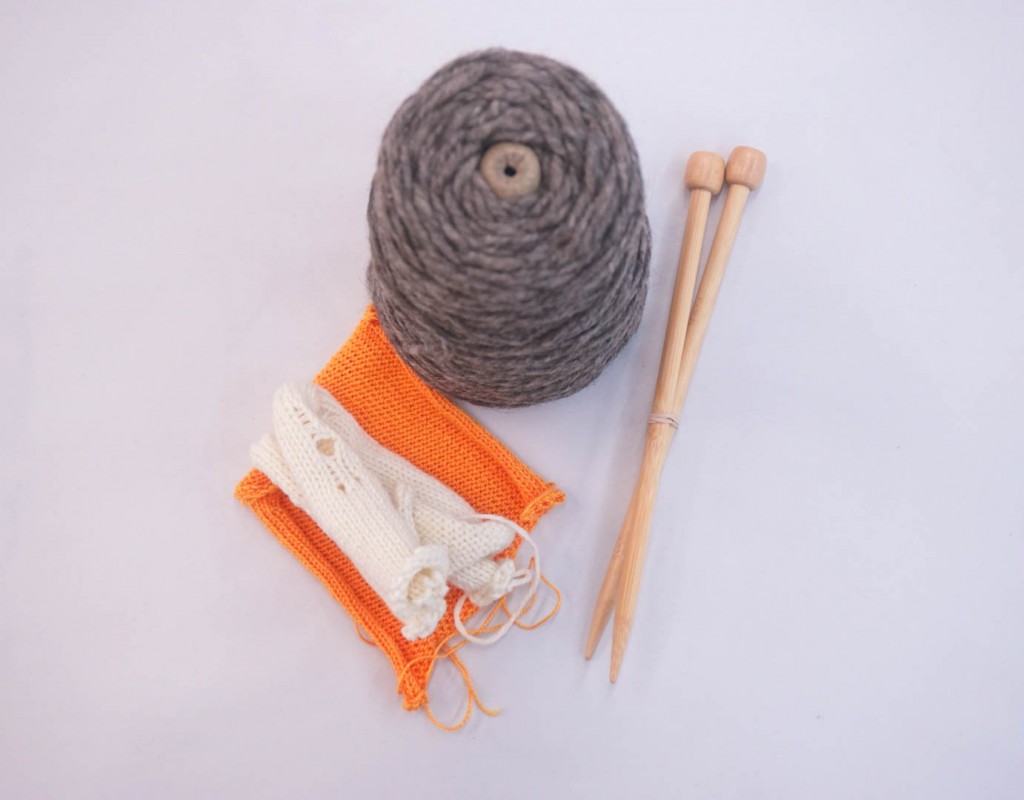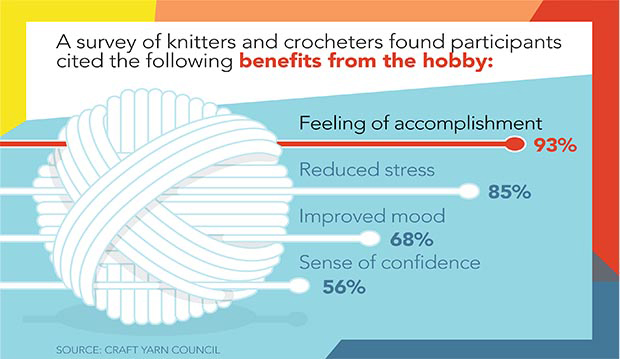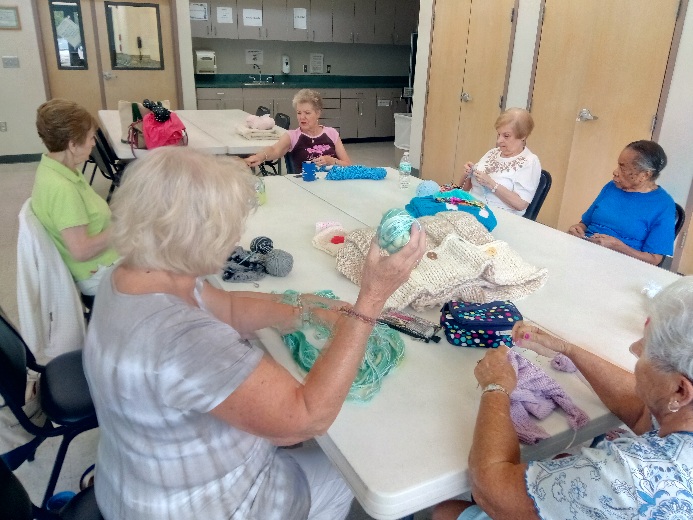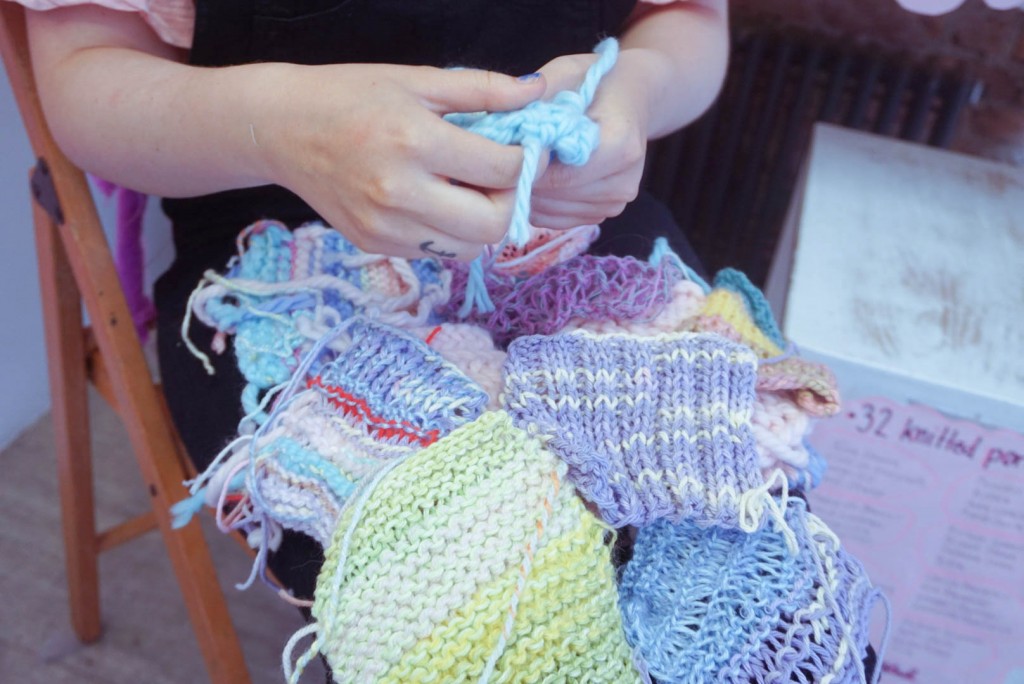Knitting as Therapy
Growing up has its challenges. Each one of us finds obstacles in our path. For some of us, including myself, those obstacles came in the form of physical disabilities. I sometimes like to refer to them as “differences”, and not necessarily as obstacles but as “challenges." For many at any age, including myself, these challenges are fine motor skill related. As I’ve journeyed into adulthood and found a love of the arts lurking within me, I have realized many artistic outlets where I can convince my hands and my eyes to work together. As I grew to understand that therapy can be found anywhere I look, my mother realized the same of her knitting group. While I am focused on fine motor skills, her geriatric friends are focused on their own cognition. As patients we must use any and all therapies available to us in order to heal. Within the textile arts knitting has not only been used as an occupational therapy, but also to reduce stress, anxiety, and depression while helping us retain cognitive brain function and physical dexterity in old age.
One of the most notable uses of knitting is in Occupational Therapy, or “OT” for short. The US Bureau of Labor and Statistics describes this work as follows, “patients with injuries, illnesses, or disabilities through the therapeutic use of everyday activities. OT helps patients develop, recover, and improve the skills needed for daily living and working.” Needle arts as therapy serves a number of different purposes. While it does help improve fine motor skills, it also improves cognitive abilities, allowing the body to heal in more than just one way. There are a number of reasons it works so well. One school of thought teaches that within “craft therapy” there is no right and wrong, meaning that patients are improving themselves in a demanding yet stress free environment. The first time I knitted was in a anachronistic summer camp. It was labeled “quiet knitting time," the preteen equivalent to nap time. The camp, set in a historic house from the 1700s creaked beneath the children sitting cross legged, while the counselor read from a book of the era. The activity soothed me with repetitive motion, where even a mis-stitch was easily fixed. When the camp ended I continued the practice for a time. My Mother, a knitter, must have noted how wonderfully at ease I seemed (although I’m sure she saw an active boy inside squirming), and I remember the pride I felt in my creation, even though all I ever produced was a beautifully soft knitted cylinder that stretched six feet. It was the sense of accomplishment within the practice that lead to its benefit in my development, a point experts agree on.
In the modern age, the textile arts are being widely used to help manage stress, anxiety, depression, all of which contribute to rumination.
A study by Bissell and Malloux notes that OT used crafting to treat the mentally ill until World War I when it was adopted to treatment of returning combat veterans. Post war, there was a major upswing in the use of knitting and other crafts in OT. “The use of crafts was discussed in terms of physical factors such as strength, coordination, and endurance, as well as psychological and social aspects such as problem solving, decision making, self-esteem development and group socialization." This was the height of crafting in therapy. The study by Bissell and Malloux completed in the early 80s is still one of the only ones of its kind. The study found that three out of four occupational therapists used crafting as a therapy, but only 20% of the time. The chief reason for such an underwhelming statistic is that crafting as therapy cannot be measured. While the physical strength of the patient can be tracked, it is next to impossible to numerically measure the psychosocial aspect. “Occupational therapists might see huge benefits to crafting but if they can’t offer measurable proof that their methods are working then they may not be able to get the money they need to keep their methods going." This is perhaps why I, as a patient, never encountered knitting as OT when I was inevitably pulled out of class for therapy. As an elementary student of the early 1990s my opportunity to discover this therapy was never realized. I don’t assume that in therapy knitting’s hayday, the OT of developmentally disabled young people was a priority. While, for my purposes, drawing and bouncing a ball made the cut, knitting never did.
Knitting produces something tangible which in turn raises the knitter’s self-esteem and self-worth.
In the modern age, the textile arts are being widely used to help manage stress, anxiety, depression, all of which contribute to rumination (focusing on one’s distress), and other similar psychological maladies. “A 2007 study conducted by Harvard Medical School’s Mind and Body Institute, found that knitting lowers heart rate, by an average of 11 beats per minute, and induces an ‘enhanced state of calm,’ similar to that of yoga.” Not only can simple knitting immediately reduce heart rate, but with some practice, knitting can aid in lowering blood pressure, and eventually even in reducing cortisol levels. Unlike the aforementioned meditative therapies, knitting produces something tangible which in turn raises the knitter’s self-esteem and self-worth.
Studies also find that knitting can enhance socialization and promote a calm environment. A 2009 study found that in 72% of anorexic women, knitting daily lead to a decrease in rumination, which in turn leads to a higher rate of progress in therapy. Meanwhile, Betsan Corkhill, author of “Knit for Health and Wellness” found, through her website, “Stitchlinks” that 54% of chronically depressed knitters saw a reduction in symptoms while knitting. Additionally Corkhil found that almost 100% of knitters suffering from chronic pain saw a reduction of symptoms while knitting.
The most interesting statistics (even more relevant to the older knitter) is how knitting helps the retention of cognitive brain functions. A 2011 study at the Mayo Clinic of 1,300 people between the ages of 70 and 89, most of whom were cognitively normal, was conducted to determine what cognitive activities they engaged in later in life. “The study, published in the Journal of Neuropsychiatry & Clinical Neurosciences, found that those who engaged in crafts like knitting and crocheting had a diminished chance of developing mild cognitive impairment and memory loss.” This proves without a doubt that knitters are happier longer. A point my knitter mom agreed on. While discussing this research with her she noted her own knitting circle. My parents live in one of those western Florida over 55 communities, and my mother is considered the spring chicken of her knitting group at 65, the oldest being 92. They call themselves “The Sew Whats” and she did not hesitate to point out that every single one of them can knit, count their stitches and hold a conversation, most of the time with little to no error.
The activity of knitting in patients with dementia can slow the onset by as much as 50%, as well as helping to stabilize its progression.
There are a number of reasons why knitting is so good at helping maintain cognitive abilities. The parts of our brains specifically activated by knitting are memory and attention span, the two brain functions affected most by dementia. When a person with onset dementia knits, it works these brain centers out much like a muscle. The activity of knitting in patients with dementia can slow the onset by as much as 50%, as well as helping to stabilize its progression. However, all studies done on retention of cognitive abilities in knitters point out that all subjects who showed a positive outcome from knitting had learned to knit well before their dementia was diagnosed, meaning that in order to benefit from the effects of knitting one should already be, at least, a beginner knitter. A point my Mother confirmed, as all of the "Sew What's" learned to knit when they were younger women. When using knitting to improve cognitive retention there is no limit. Meaning, that as one improves, as their brain muscles recall and allow them to be proficient in certain patterns, speed, and difficulties, a patient can move on to a more and more difficult level of knitting. This allows patients to improve cognitive abilities and fight the symptoms of dementia.
Surveys show that there is a huge uptick in crafting, specifically knitting, as a social community builder and art form among millennials besides it being a way to reduce to stress. Hopefully, in the future, the medical community will come to widely accept knitting as a form of cognitive, occupational, and psychological therapy. Until then, pick up a pair of needles, some yarn, join a knitting circle, and stitch your heart out!
Works Cited
www.AARP.org, This is No Yarn: Knitting May Help Keep Your Mind Sharp, Janice LLoyd. https://stayingsharp.aarp.org/art/connect/16/knitting-brain-benefits.html
www.Independent.co.uk, Knitting Can Reduce anxiety, Depression Chronic Pain Slow Dementia, Research Reveals, Chelsea Ritchel, 2018. https://www.independent.co.uk/life-style/knitting-reduces-anxiety-depression-chronic-pain-slows-dementia-research-knit-for-peace-uk-a8254341.html
www.sprucecrafts.com, Crochet as Occupational Therapy, Kathryn Vercillo, 2018. https://www.thesprucecrafts.com/crochet-as-occupational-therapy-4097170
www.alzheimers.org.uk, A knitting group providing a way for people with dementia to remain involved in the community.
https://www.alzheimers.org.uk/get-support/publications-and-factsheets/dementia-together-magazine/knitting-group-providing-way-people-dementia-remain-involved-community
www.well.blogs.nytimes.com, The Health Benefits of Knitting, Jane E. Brody, 2018. https://well.blogs.nytimes.com/2016/01/25/the-health-benefits-of-knitting/
Personal Interview with Arlene Natalo, Matriarch and avid knitter, August 2018.



